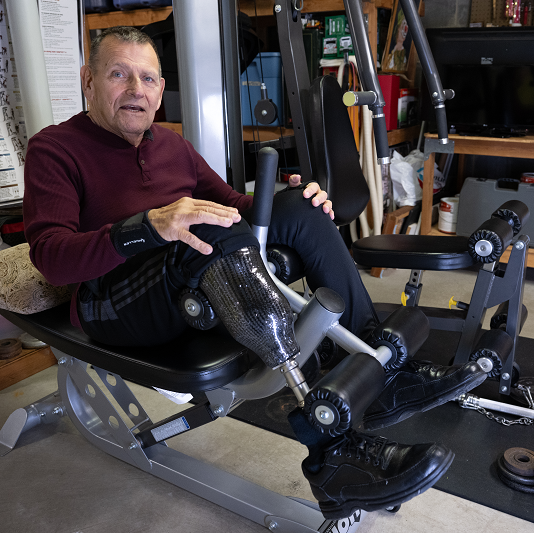Retired NJ Postal Carrier Finds New Energy in New Knee

October 17, 2024
When 67-year-old John Drexler of Clifton, New Jersey, began feeling knee pain, he logically thought it was a result of his long career as a letter carrier for the U.S. Postal Service. After all, his job required a lot of daily walking.
But earlier this year, while walking in his home hallway, he heard a crunching sound and knew that wasn’t good.
John scheduled an appointment with orthopedic surgeon Yair David Kissin, M.D., at Hackensack University Medical Center, who ordered X-rays of John’s knees before the exam.
“As John was on his way to see me for his appointment, our X-ray technician in outpatient radiology called to alert me that she’d seen something unusual in his imaging—and indeed she had,” Dr. Kissin says. “I sat John and his wife down to explain that the surprising finding needed to be evaluated, and he should be admitted to the hospital.”
That surprise finding was a fracture of the distal femur or thigh bone. The fracture didn’t look like a normal break caused by injury, but rather like a fracture caused by a disease. Dr. Kissin thought that it could be malignant—as in cancer. “I took him to the Emergency Department myself,” Dr. Kissin says.
Quick Action to Address Surprise Tumor
Dr. Kissin referred John to orthopedic oncologist and division chief Francis Patterson, M.D., who specializes in bone and soft tissue tumors. Dr. Patterson arranged an immediate MRI, CAT scan and bone scan. Within 24 hours, John was in surgery for a distal femoral replacement, essentially a complex form of knee replacement.
Fortunately, pathology showed that John’s tumor was benign. His type of tumor is called a giant cell tumor, which is extremely rare and can appear at the lower end of the femur on the knee.
“While benign, this type of tumor can be very aggressive,” Dr. Patterson says. The slightest act, such as coughing or bumping into something, can cause the bone to break when the tumor is advanced.
John’s surgery was a success. “I got up the next day and walked a bit,” he says. “I started with a walker, then a cane, did some physical therapy and after two months, I was basically walking on my own.”
From Total Uncertainty to a Total Fix
Dr. Patterson says a typical recovery time for John’s surgery is approximately six months and that John has been doing well as he gets stronger and more independent.
“I know it was a roller coaster of emotions for him and his wife, from total uncertainty to knowing that what was wrong was now fixed,” Dr. Patterson says.
John talks enthusiastically about his care team of nurses, to whom he sent a giant fruit basket. “I’d love to be able to thank each nurse personally,” he says. “I play the lottery every week, and I don’t win ‘one in a million’ there. But I am one big winner here.”
Next Steps & Resources
- Meet our sources: Yair David Kissin, M.D. and Francis Patterson, M.D.
- To make an appointment with an orthopedic specialist near you, call 800-822-8905 or visit our website.
- Learn more about orthopedic services at Hackensack Meridian Health.
The material provided through HealthU is intended to be used as general information only and should not replace the advice of your physician. Always consult your physician for individual care.








